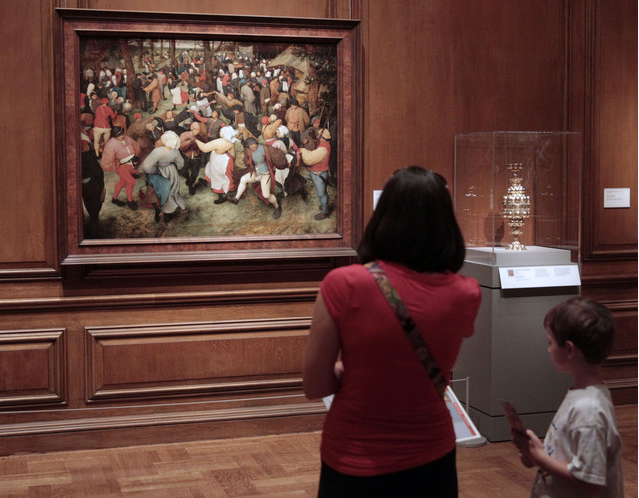Detroit’s Art Collection may be sold
Jul 24th, 2013 | By Ivan Lindsay | Category: JournalThe sharks have already started to circle Detroit’s Art Collection following the City’s recent bankruptcy. The billion dollar art collection, one of the ten most important museum collections in North America, and containing around 60,000 artworks, is apparently on the table as a possible partial solution for the city’s creditors. However, a sale of such a collection would be unprecedented and bound to throw up plenty of legal issues such as art works that have been given to the museum as bequests. Christie’s have apprently already sent up two of their staff to have an initial look around. Bloomberg recently published an article online which covers most of the issues involved:-
Bloomberg, July 24th
Art experts yesterday reacted with concern at the prospect of masterpieces from the Detroit Museum of Art including works by Bellini, Rembrandt, Van Gogh and Picasso, suddenly flooding the global market. That possibility looms in the wake of the biggest U.S. municipal bankruptcy filing by the city on July 18. The Detroit collection has been valued at more than $1 billion.
As ravenous as collectors and new museums are, there are limits, even in the Persian Gulf. “They can’t put 100 masterpieces on the market at the same time,” said Todd Levin, a Detroit-born, New York-based director with Levin Art Group. “You will depress the market.” Detroit’s struggling managers may not share that concern. The city should be able to use assets, including artwork in the 128-year-old museum, to repay obligations, said Jon Schotz, co-managing partner at Kayne Saybrook Municipal Opportunity Funds, which has more than $300 million of distressed municipal-bond debt. Schotz declined to say whether the firm holds Detroit bonds.
The city pensions are underfunded by as much as $3.5 billion, Emergency Manager Kevyn Orr said in the filing. “The creditors have said everything is on the table,” said Bruce Babiarz, a spokesman for the Detroit Police and Fire Department. On this table are about 60,000 works, ranging from Egyptian mummies to cutting-edge contemporary art.
“The DIA is among the top 10 museums in the United States in terms of the breadth and depth of its permanent collection,” said Maxwell Anderson, director of the Dallas Museum of Art in an interview. Asked about valuations that put the collection in the billions, he said, “It doesn’t seem implausible.” The works include Diego Rivera’s 27-panel fresco “Detroit Industry,” which occupies a garden court and is a tribute to the city’s labor force of the 1930s. Rivera considered it his most successful work.
At least three paintings — Van Gogh’s “Portrait of Postman Roulin,” “The Wedding Dance” by Pieter Bruegel the Elder and “Madonna and Child” by Giovanni Bellini — could each fetch more than $150 million. “You are talking about works of such exceptional significance, they would be comparable in value to pieces like Picasso’s ‘Le Reve’ and Cezanne’s ‘Card Players,’” Beverly Schreiber Jacoby, valuation specialist and president of New York-based BSJ Fine Art, told Bloomberg News in May.
Hedge-fund manager Steven Cohen bought “Le Reve” for $150 million last year. In 2011, the royal family of Qatar paid more than $250 million for “Card Players,” according to Vanity Fair magazine. Employees of Christie’s International PLC auction house visited the museum in anticipation of being hired to do an appraisal, said a staffer familiar with the trip who wasn’t authorized to speak for attribution. “Christie’s called us and said they’re sending two people,” said Pamela Marcil, a museum spokeswoman. “We don’t know who contacted Christie’s.”
Orr, the emergency manager, has asked creditors to accept less than 20 cents on the dollar. While the museum is operated by an independent nonprofit organization, the city owns the land, building and art. “The very first thing you need to do is to have an appraisal to find out the fair market value,” said Elizabeth von Habsburg, managing director of Winston Art Group, an independent art appraisal and advisory firm. “It’s disheartening but it’s very sensible.”
In a statement on the day of the bankruptcy filing, the museum said it and the city “hold the DIA’s collection in trust for the public and we stand by our charge to preserve and protect the cultural heritage of all Michigan residents.” Thomas Kline, a Washington lawyer with Andrews Kurth LLP who specializes in art law, said there’s no precedent for an $18 billion municipal bankruptcy in which a municipality considers selling cultural assets to raise funds. “It could take at least a couple of years to sort this out,” Kline said, citing in part covenants associated with donations. “There is certainly a possibility for multiple lawsuits concerning the right to sell art to pay the creditors.”
Anderson, one of the country’s most highly regarded museum directors, was unequivocal in his opposition to a sale. “This is unprecedented in my experience,” he said. “It seems reckless to even consider liquidating these public assets.”
The case is City of Detroit, 13-bk-53846, US Bankruptcy Court, Eastern District of Michigan (Detroit).


[…] just when we thought things couldn’t worsen, Detroit’s vast art collection has fallen into the sights of those seeking a resolution to the city…. Detroit’s Institute of Art Museum is ranked as one of the ten best in North America and its […]